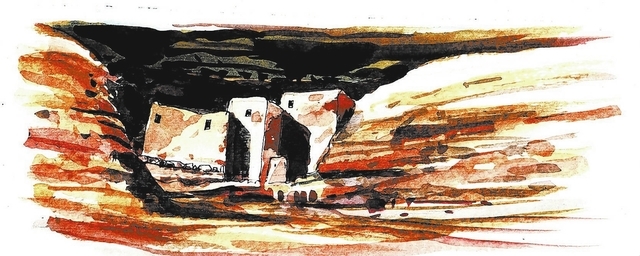Montezuma Castle preserves majestic ruins
Recognized as one of the best-preserved cliff dwellings in North America, Montezuma Castle in central Arizona annually draws about 350,000 visitors.
It was one of the four sites protected as national monuments in 1905 by President Theodore Roosevelt and remains the most popular prehistoric architectural site in Arizona.
A culture now called the Sinagua started building the cliff dwelling 900 years ago and occupied it for about 300 years.
Montezuma Castle National Monument is about 250 miles from Las Vegas. Follow U.S. Highway 93 to Kingman, Ariz., then merge onto Interstate 40 and head east to Flagstaff. At the junction, turn off I-40 and head south on Interstate 17. About 50 miles south of Flagstaff, get off the freeway at exit 280. Drive east about half a mile and turn left at a blinking red light onto Montezuma Castle Road.
The monument preserves 826 acres along Beaver Creek, a tributary of the Verde River. It is just five miles from the town of Camp Verde. The monument includes another Sinagua site 11 miles away at Montezuma Well, a limestone sinkhole filled with warm water where the Sinagua built dwellings beneath the rim as well as pueblos and pit houses near the rim. The same culture also lived along the Verde River and other tributaries, leaving ruins at several locations, including Tuzigoot National Monument.
Start your visit to Montezuma Castle at the visitor center, where you pay a $5 entry fee (waived for park pass holders). If you visit Tuzigoot, show your receipt to receive a $2 discount on that entrance fee.
There is no fee to visit Montezuma Well. It is small but unusual, beautiful and well worth the short drive. Return to I-17 and drive north four miles to exit 293. Drive four more miles through the small communities of McGuireville and Rimrock to the entrance.
A half-mile trail takes you below the rim and past the single-story dwellings tucked back into the limestone. The tranquil well, fed by deep water sources, is so mineralized that fish cannot live in it, but the aquatic organisms that thrive there are found nowhere else. Sinagua drinking the water would have ingested a lot of arsenic.
The Montezuma Castle visitor center provides an introduction to a culture that vanished a couple of centuries before the Spanish reached the New World. Because Montezuma Castle was looted in frontier times, most of the artifacts displayed in the museum there came from excavations of the other ruins at the site. The visitor center also has a nice bookstore and gift shop, restrooms and a nearby picnic area.
Follow the shady loop trail about a third of a mile from the visitor center to get close to the cliff dwellings and other ruins. The Sinagua living along Beaver Creek built a variety of dwellings, including a 40-room pueblo at the base of the cliffs, pit houses, single-room dwellings and storage granaries. The builders of the five-story, 20-room structure now called Montezuma Castle chose to construct it 50 feet above ground level in a niche in limestone cliffs beneath an overhang. Protected from the elements, its walls outlasted other structures nearby.
Life along Beaver Creek would have been pleasant. Although surrounded by desert, the creek created a verdant area with many kinds of plants. Trees like the sycamores, ash, cottonwoods and walnuts shading the trail today were useful to residents centuries ago. The water attracted a variety of birds and other wildlife and was home to fish and other aquatic creatures.
The industrious Sinagua lived quite well. They hunted, fished and gathered plants for food, medicines and other purposes. They diverted the creek water into irrigation channels to water crops of beans, squash, corn and cotton, made baskets and beautiful pottery and found a source of salt in the vicinity. The Sinagua traded with other groups over long distances, returning with items they did not produce themselves or things found only elsewhere. Their disappearance around the same time as other cultures across the Southwest remains a mystery yet to be solved.
Margo Bartlett Pesek’s Trip of the Week column appears on Sundays.






















